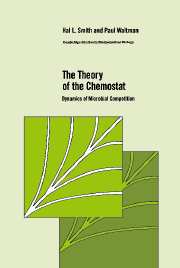Book contents
- Frontmatter
- Contents
- Preface
- 1 The Simple Chemostat
- 2 The General Chemostat
- 3 Competition on Three Trophic Levels
- 4 The Chemostat with an Inhibitor
- 5 The Simple Gradostat
- 6 The General Gradostat
- 7 The Chemostat with Periodic Washout Rate
- 8 Variable-Yield Models
- 9 A Size-Structured Competition Model
- 10 New Directions
- 11 Open Questions
- Appendices
- References
- Author index
- Subject index
2 - The General Chemostat
Published online by Cambridge University Press: 07 December 2009
- Frontmatter
- Contents
- Preface
- 1 The Simple Chemostat
- 2 The General Chemostat
- 3 Competition on Three Trophic Levels
- 4 The Chemostat with an Inhibitor
- 5 The Simple Gradostat
- 6 The General Gradostat
- 7 The Chemostat with Periodic Washout Rate
- 8 Variable-Yield Models
- 9 A Size-Structured Competition Model
- 10 New Directions
- 11 Open Questions
- Appendices
- References
- Author index
- Subject index
Summary
Introduction
In the previous chapter it was shown that the simple chemostat produces competitive exclusion. It could be argued that the result was due to the two-dimensional nature of the limiting problem (and the applicability of the Poincaré–Bendixson theorem) or that this was a result of the particular type of dynamics produced by the Michaelis–Menten hypothesis on the functional response. This last point was the focus of some controversy at one time, inducing the proposal of alternative responses. In this chapter it will be shown that neither additional populations nor the replacement of the Michaelis–Menten hypothesis by a monotone (or even nonmonotone) uptake function is sufficient to produce coexistence of the competitors in a chemostat. This illustrates the robustness of the results of Chapter 1. It will also be shown that the introduction of differing “death rates” (replacing the parameter D by Di in the equations) does not change the competitive exclusion result.
A brief mathematical digression on Liapunov stability theory will set the stage for the results of this chapter. Those familiar with the LaSalle corollary to Liapunov stability theory, also called the “invariance principle” by some authors, can skip immediately to Section 3.
Liapunov Theory
A more sophisticated mathematical approach is required for the results of this chapter because the equations considered cannot be reduced to planar systems. The theorem described in this section and used throughout this chapter is one of great power.
- Type
- Chapter
- Information
- The Theory of the ChemostatDynamics of Microbial Competition, pp. 28 - 42Publisher: Cambridge University PressPrint publication year: 1995
- 1
- Cited by



